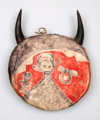The exhibition, Plains Indian Art: Created in Community, will explore the unparalleled talent of certain individuals and the special role of Plains artists in their communities. This exhibition will highlight Plains art as an expression of cultural tradition and community vibrancy, focusing specifically on generational change in style and function and the innovative techniques used by various artists. The visitor will learn how art is created within Native American communities as well as understand the shifting cultural meanings of certain artistic expressions. This exhibition also celebrates the different approaches — including the curator, historian and artist approaches — to understanding Native American art.
In the second and third quarters of the 19th century, Plains Indian culture reached a zenith of artistic expression and development. The re-introduction of the horse shortly after 1680, when the Spanish territory formed in the south, and the introduction of firearms around 1720 from French fur traders based in the Great Lakes area gave the Plains Indians the mobility and the armaments needed to create a food surplus based primarily on buffalo hunting. The food surplus in turn gave the Plains tribes the leisure time to create and excel in artistic expression. Some of the finest Plains Indians art of the 19th and early 20th centuries can be found in Tulsa, Oklahoma. In the vast collection of Gilcrease Museum are about 25,000 ethnographic items, many of which reflect the height of Plains cultural and artistic achievement of the 19th century.
A Visiting Scholars Program at the Helmerich Center for American Research hosted a symposium on November 13, 2015, that focused on the study of the Plains Indian ethnographic collection at Gilcrease Museum and the private collection of Jon Stuart. Six scholars made presentations on a variety of topics related to the theme of “Art and Artistry of Plains Indian Communities,” focusing on recently conducted research.
Among the speakers for the symposium and cocurators of the exhibition were Gaylord Torrence (Nelson-Atkins Museum of Art), who discussed the tobacco bags and parfleche at Gilcrease Museum and the Jon Stuart collection; Emma Hansen (Buffalo Bill Historical Center), who analyzed the Cheyenne ledger books in the Gilcrease collection; and David Penney (Smithsonian), who examined the larger theme of tribal attribution. Duane King (Helmerich Center for American Research) explored the art of White Swan, a Crow Scout with Custer’s 7th Cavalry who survived the Battle of the Little Big Horn but who was permanently disabled from wounds suffered in the battle and turned to art as a means of preserving the record of his military accomplishments. A contribution by Jennifer McKinney (Oklahoma State University) examined the photography and art associated with the 1862 Sioux uprising. The papers written for the symposium will serve as the storyline for the exhibition that will open at Gilcrease Museum in February 2017. The papers presented at the symposium will be published in a highly illustrated companion volume for the exhibition.
Plains Indian Art: Created in Community will guide museum visitors through an exploration of art and artisan works by Plains women and men beginning with beadwork and quillwork applied to dress clothing, such as shirts, dresses, vests, leggings, and moccasins, continuing through beadwork and quillwork on children’s items, such as baby carriers, as well as pipe bags. The artwork of individuals from various Plains cultures will be represented, including Kiowa, Lakota, Mandan/Hidatsa, Cheyenne, and Crow, among many others. The exhibition will also feature sections devoted to pictographic war records, the Native American Church, and outstanding contemporary American Indian artistic creations.




